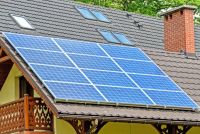The common logic would make you think that the more sun the better it is for the output of solar cells. But this isn’t always the case. In fact, too much sun and too much heat can reduce the efficiency of solar cells.
As operating temperature rises by 1 degree Celsius, traditional silicon-based solar cells lose around 0.5% efficiency. This means that in a typical solar power plant, where modules operate nearly 25 degrees Celsius above the ambient temperature, energy losses can reach 12%.
This is why solar farms need adequate cooling methods. There are several modern cooling methods, some of them using wind or water to interact with solar panel surfaces, while others employ specific materials with less thermal sensitivity.
The downside of these cooling methods is that these techniques require significant resources to operate and this is why researchers look for other alternatives. Some researchers suggest that solar farm with optimally spaced panels facing the correct direction could even cool itself through convection using the surrounding wind.
For instance, just by raising the height of solar cells and increasing the spacing between panel rows the researchers managed to increase power output by 2% to 3%.
This could lead to more accurate energy generation and cost prediction models in solar energy industry.
